Optimize Triathlon Success: Water Running and Aqua Jogging for Injury Prevention and Low-Impact Training
 Karen Parnell
May 20, 2022
Karen Parnell
May 20, 2022
 Optimize Triathlon Success: Water Running and Aqua Jogging for Injury Prevention and Low-Impact Training
Optimize Triathlon Success: Water Running and Aqua Jogging for Injury Prevention and Low-Impact Training
Think you can’t train for an IRONMAN, triathlon or running event coming out of injury? Maybe you are training for a marathon or ultra but need a low impact alternative.
Low impact water running, or aqua jogging could be an answer to keep active and form part of your rehab. Alistair Brownlee used water running to come back from an Achilles tendon injury to race at the 2012 Olympics.
My 12-week IRONMAN 70.3 training plan on FinalSurge features water running options along with structured heart rate, power and strength sessions. This is the perfect training plan for someone coming back from injury or wanting a lower-impact training plan.
Water running or “aqua jogging” has long been used for rehabilitation, but I have found that it’s a great way to insert an effective low-impact running session into your weekly training regime.
You can get a good cardio workout if you follow a structured training session and push hard against the water. If you are using this type of session for rehabilitation, then push to a point that is comfortable—water running should never hurt.
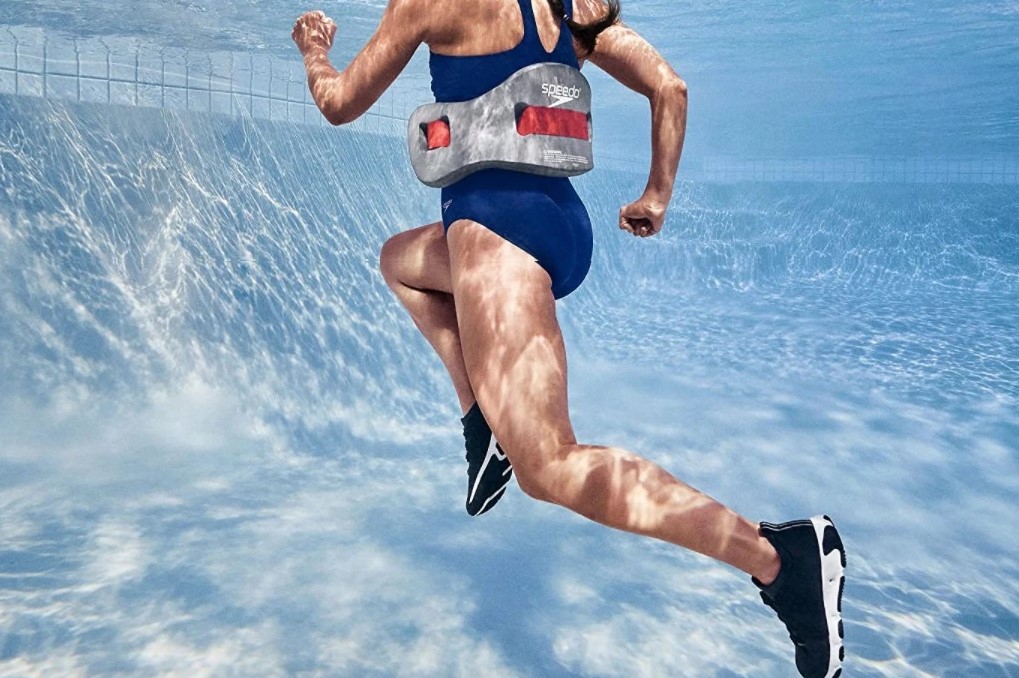
Get your FREE Swim Workouts for Triathletes E-book
Why run in water?
Water is 830 times denser than air so your movements with be slower but effective. It provides buoyancy and support for the body, making it less likely for your muscles, bones and joints to get injured. The water also keeps you cool so it’s a comfortable workout. Still, remember to drink water while you train.
Research shows deep water running is relatively close to real running in terms of cardiovascular demand at easy-to-moderate intensities. You can expect to maintain your fitness for four to six weeks by water running during injury recovery. Here are the nine main benefits of water running:
- Great for coming a back after injuries. If you have suffered from an injury that requires you to take time off from your activity, but you are concerned about losing any fitness gains, water running may be a safe alternative to keeping you active and help maintain your fitness level.
- Prevents repetitive injuries. Running in water is a great tool for preventing injuries associated with a heavy volume of aerobic training.
- Cross training option. Water running is an optimal cross-training option for many athletes and fitness enthusiasts. It adds another dimension and variety to your workouts without the risk of injury.
- Excellent for novice runners and new fitness enthusiasts. Great for beginners who are learning to run and need a cross-training option.
- Recovery tool. Water running can be used as a recovery tool to facilitate the repair of damaged muscles after hard workouts.
- Specific to runners. Since water running closely mimics the natural running it provides a neuromuscular workout and helps keep the specific running muscles active.
- Total body workout. Water running is a total body workout that strengthens your legs, arms, and core
- Maintains your fitness. It is safe for almost any type of injury but if you have had an injury check with your doctor first.
Strengthens your cardiovascular system. Running against the resistance of water using both the upper body along with the lower body also makes deep-water running a great challenge for the cardiovascular system.
Here's 5km runner and Olympian Eilish McColgan using aqua jogging to help come back from injury and improve here running times:
Get your FREE Swim Workouts for Triathletes E-book
Water Running Gear
In order to help keep you buoyant, a floatation belt can be used. You also need a pool deep enough so that you can run with legs dangling or suspended so that your feet don’t touch the bottom of the pool. You may also like to use Aqua Fitness Shoes.
Example of a flotation belt: Beco Unisex Adult Aqua Jogging Belt
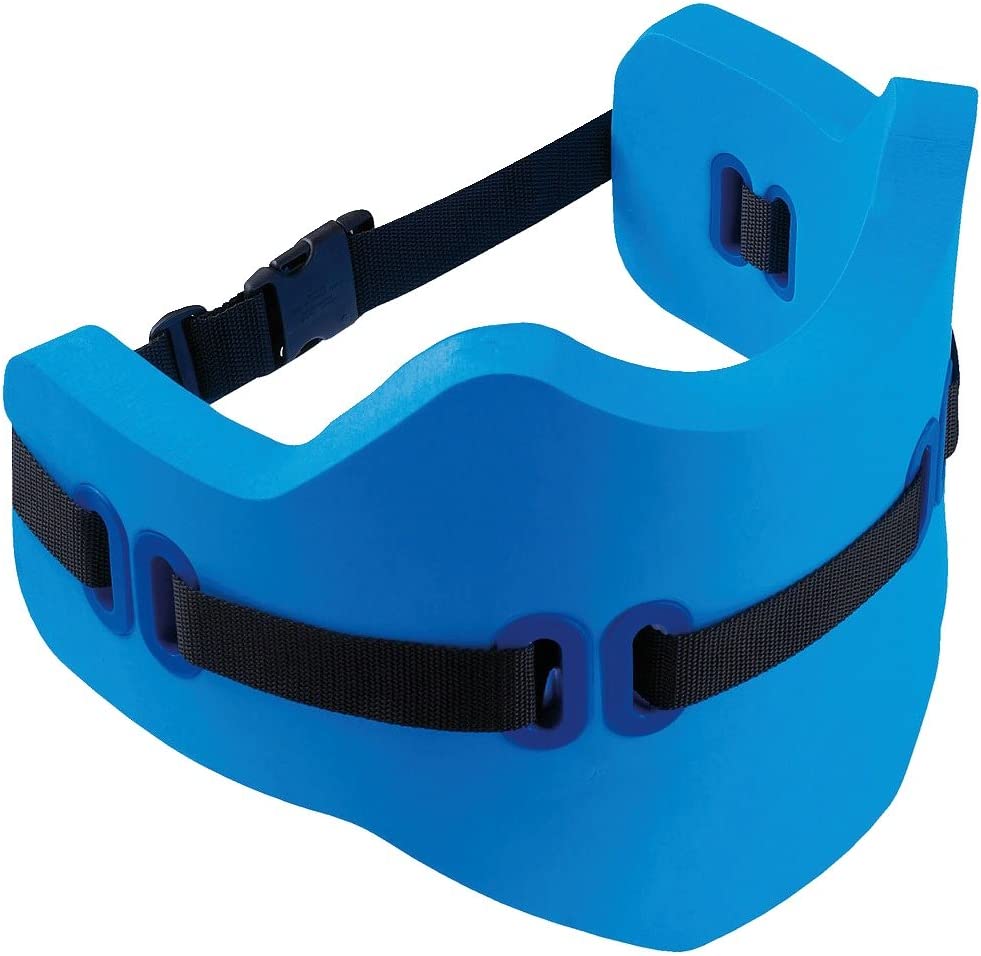
An example of aqua jogging shoes
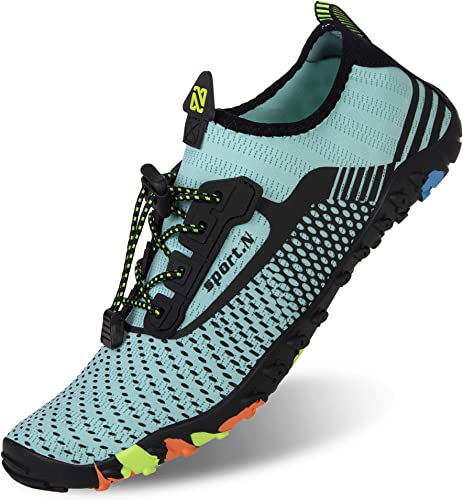
Another option for aqua running shoes are Skinners. These are ideal for aqua jogging plus open water swimming. I use mine for sea swimming as they have a tough rubber sole to avoid cutting my feet on rocks. You can also walk and running them.
Amazon: Skinners 2.0 minimalist shoe socks (unisex)
£39
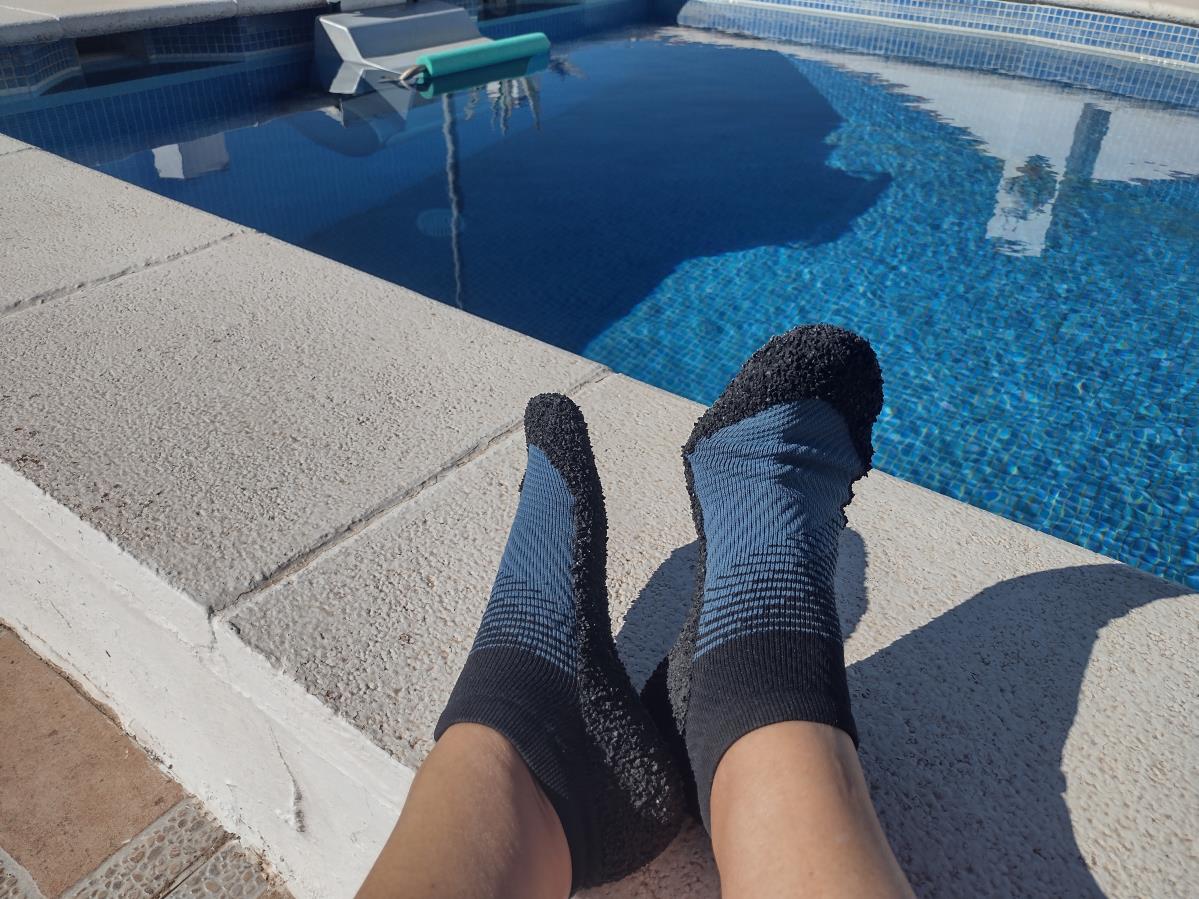
Get your FREE Swim Workouts for Triathletes E-book
Tips on how to properly water run
Posture is important in water as it is on land. When water running, the body should remain as vertical as possible, do not lean forward at the chest. Your arms and legs should be pumping like the motion of running on land. You should be closely mimicking your normal running action, albeit slower. Using a flotation belt helps keep your posture upright and prevent you from sinking to the bottom.
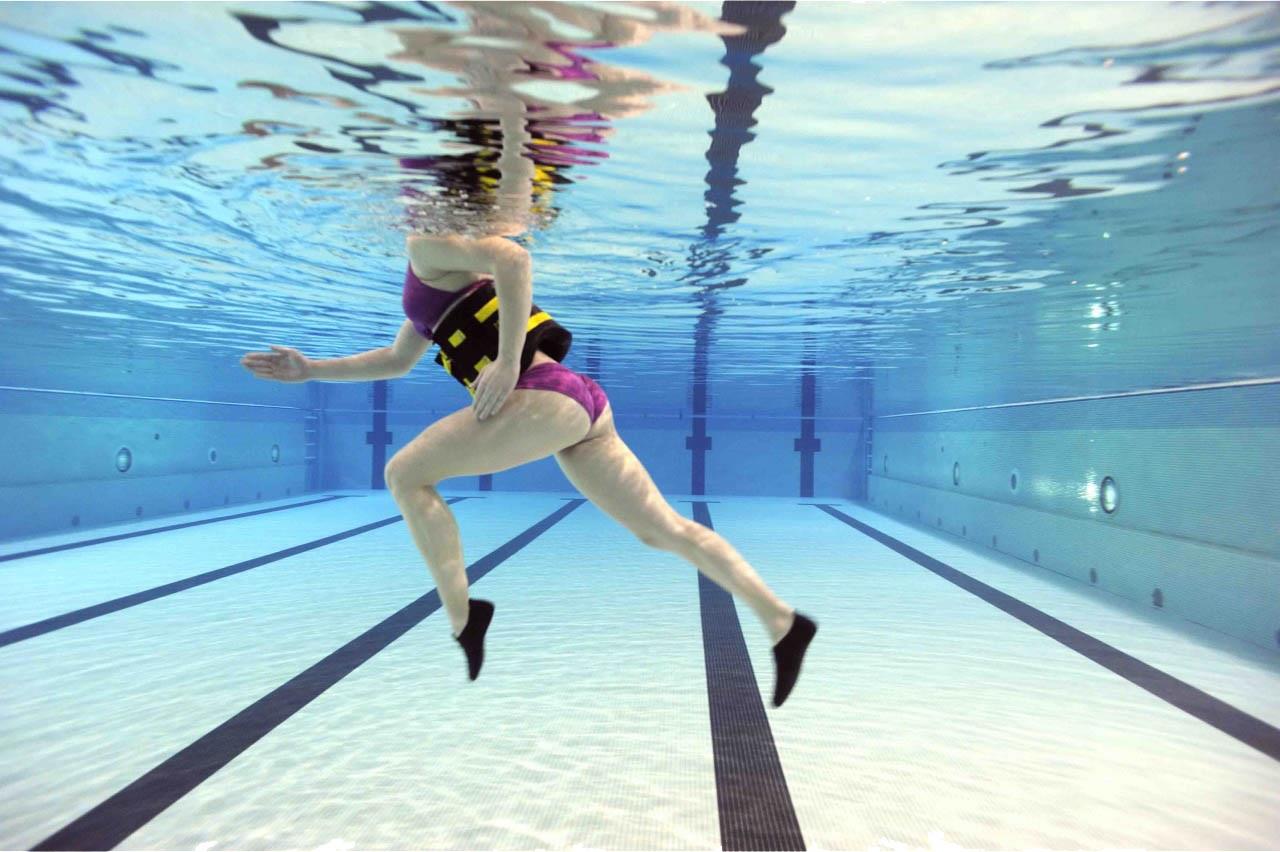
Get your FREE Swim Workouts for Triathletes E-book
Water Running Safety tips
- Try to simulate your normal running style.
- Don’t paddle with an open hand or cupped hand. Keep a loosely closed fist and let your legs move you forward.
- Try to let the bottoms of your feet kick the water behind you.
- Take short, quick strides. A fast cadence intensifies the workout.
- Expect a lower stride cadence for your usual amount of effort. Remember that water is more resistant than air and your pace will decrease accordingly.
- Your heart rate may surprise you. Even though you can feel your rate of effort, your heart rate will be about 10% lower than at the same intensity on land.
How to integrate water running in to your training
For deep water running to be effective for fitness maintenance, it should be done at the same intensity, frequency, and duration as your normal runs.
Water running should not replace all your runs but should be considered as cross-training, or replace one running session per week if you’re coming back from injury or wanting a low impact alternative.
Your sessions should take the form of a warmup, main session with intervals and warm down. An example could be:
Basic deep water running circuit workout format
- Warm-Up: 5 to 10 minutes at a comfortable pace with stretching
- Intervals: 20 to 40 minutes of varied intensity intervals
- Cool-Down: 5 to 10 minutes at a light pace followed by stretching
In addition to jogging, you might want to add in some other movements to make your workout more fun and intense. During the interval portion of your workout, intersperse bursts of running movements with sets of sidekicks, knee lifts, heel kicks, and arm rotations.
The sessions in the FinalSurge training plan are more comprehensive with full details of the moves and specific training goals.
Fluid Running
Jennifer Conroyd is a runner and convinced that water running works for athletes and had developed Fluid Running. She teaches classes, personal trains and has developed a series of videos so you can train where ever you live. If you want tips on where to start visit here site Fluid Running.
Get some FREE resources including training plans here Chili Tri
Conclusion: Water Running For Athletes
In summary, water running, or aqua jogging, is a fantastic option for runners and triathletes looking to stay fit or recover from injuries. It's gentle on the body yet highly effective, offering a low-impact workout that strengthens muscles and boosts endurance without straining joints.
Whether you're a marathon enthusiast, triathlon rookie, or someone on the mend, aqua jogging is accessible and adaptable to all levels of fitness. Beyond physical benefits, it provides a refreshing mental break, offering a sense of calm and rejuvenation amidst the soothing waters.
Karen Parnell is a Level 3 British Triathlon and IRONMAN Certified Coach, 8020 Endurance Certified Coach, WOWSA Level 3 open water swimming coach and NASM Personal Trainer and Sports Technology Writer.
Karen has a post graduate MSc in Sports Performance Coaching from the University of Stirling.
Need a training plan? I have plans on TrainingPeaks and FinalSurge:
I also coach a very small number of athletes one to one for all triathlon and multi-sport distances, open water swimming events and running races, email me for details and availability. Karen.parnell@chilitri.com
Get your FREE Guide to Running Speed and Technique
Get your FREE Swim Workouts for Triathletes E-book
Get your FREE Open Water Swimming Sessions E-Book
A great form of holistic wellness, aqua jogging is gaining traction in the fitness community. By embracing this fluid form of training, you're not just investing in your physical health but also aligning with the evolving trends in fitness and well-being.
So, whether you're sidelined by injury, seeking a change of pace, or simply eager for a refreshing workout, give aqua jogging a try. It's an complementary activity that promises to keep you moving forward—physically and mentally.
I did make a DIY water treadmill for my pool which was fun to make and fun to use.
 DIY Treadmill at ChiliTri in Spain - it was fun to make!
DIY Treadmill at ChiliTri in Spain - it was fun to make!
FAQ: Why water running is beneficial for cross-training and rehab for runners and triathletes
What is water running?
Water running, also known as aqua jogging, is a form of exercise performed in water, typically in a pool. It involves mimicking the running motion while wearing a flotation device or using specialized equipment to maintain buoyancy.
How does water running benefit runners and triathletes?
Water running offers several benefits for runners and triathletes, particularly in cross-training and rehabilitation:
- Low-impact workout: Water running is a low-impact exercise that reduces the stress and impact on joints, muscles, and bones compared to running on land. It provides an opportunity for active recovery or injury rehabilitation without further straining the body.
- Cardiovascular conditioning: Water running is an excellent cardiovascular exercise that elevates heart rate and improves cardiovascular fitness. It helps maintain or improve endurance levels without the pounding stress of running on land.
- Maintains running-specific movements: Water running closely simulates the running motion and engages similar muscle groups as running on land. It helps maintain and refine running mechanics, including stride length, arm swing, and leg drive.
- Strengthens lower body muscles: The resistance provided by the water during water running activates and strengthens the muscles in the lower body, including the quadriceps, hamstrings, calves, and glutes. This can help improve leg strength and power, benefiting running and triathlon performance.
- Enhances recovery: Water running promotes active recovery by increasing blood flow to the muscles and reducing post-exercise muscle soreness. It can be used as a low-intensity workout on rest days or during injury rehabilitation to maintain fitness while allowing the body to recover.
- Injury rehabilitation: Water running is often used as a rehabilitation tool for runners and triathletes recovering from injuries, such as stress fractures, shin splints, or joint issues. The buoyancy of the water reduces the impact and stress on injured areas while allowing for gentle movement and muscle activation.
- Temperature regulation: Training in water provides a cooling effect, especially in hot weather or during intense training periods. It helps regulate body temperature and prevents overheating during workouts.
How should I incorporate water running into my training routine?
Water running can be used as a cross-training activity or as a part of injury rehabilitation. Here are a few ways to incorporate it:
- Replace a running session: If you need a low-impact option, substitute a running session with a water running session to give your body a break while maintaining cardiovascular fitness.
- Active recovery: Use water running as a recovery workout on rest days or after intense training sessions to promote blood flow and aid in recovery.
- Rehabilitation: If you're recovering from an injury, work with a healthcare professional or physical therapist to develop a water running program that supports your rehabilitation goals.
What equipment do I need for water running?
For water running, you'll need a pool with sufficient depth to allow for full range of motion during your running motion. You'll also need a flotation belt or vest to help you maintain buoyancy in the water and keep you in an upright position.
How long should a water running session be?
The duration of a water running session can vary based on your fitness level, training goals, and purpose of the workout. It can range from 20 minutes to 60 minutes or more, depending on your needs and preferences.
Can water running completely replace running on land?
While water running provides numerous benefits and can be a valuable cross-training or rehabilitation tool, it does not perfectly replicate the impact and specificity of running on land. It is best used in conjunction with running on land to maintain running-specific adaptations and neuromuscular coordination.
Remember to consult with a coach, trainer, or healthcare professional to determine the most appropriate way to incorporate water running into your training routine based on your individual needs and goals.
References
Fluid Running - Deep Water Running, Pool Running, Aqua Jogging
Kwok MMY, So BCL, Heywood S, Lai MCY, Ng SSM. Effectiveness of Deep Water Running on Improving Cardiorespiratory Fitness, Physical Function and Quality of Life: A Systematic Review. Int J Environ Res Public Health. 2022 Aug 1;19(15):9434. doi: 10.3390/ijerph19159434. PMID: 35954790; PMCID: PMC9367787.
Reilly T, Dowzer CN, Cable NT. The physiology of deep-water running. J Sports Sci. 2003 Dec;21(12):959-72. doi: 10.1080/02640410310001641368. PMID: 14748454.
#traithlontrainingplans #runningtrainingplans #swimmingtrainingplans #waterrunning #aquajogging #rehab #traithlon #running
